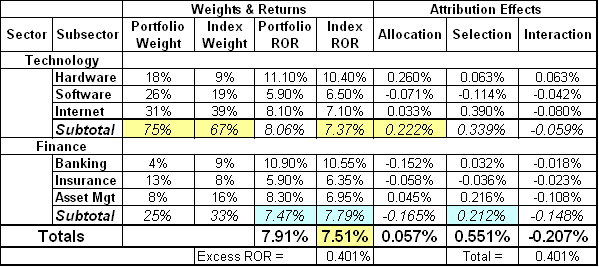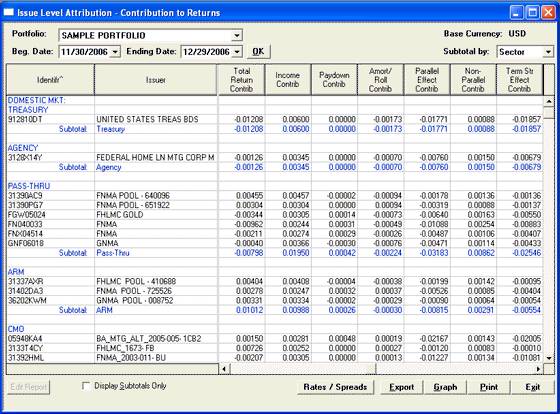Attribution Analysis
Post on: 2 Октябрь, 2015 No Comment

Attribution Analysis
To what do we attribute a manager's performance? Is it stock picking, investing in the right style, or market timing? Were certain sectors over or underweighted? These are the questions that attribution analysis attempts to answer.
To what do we attribute a managers performance? Is it stock picking, investing in the right style, or market timing? Were certain sectors over or underweighted?
These are the questions that attribution analysis attempts to answer. To answer these questions for short time periods, such as a day, a week, a month or a quarter, requires a sophisticated process that must identify and price each security in the portfolio at least daily (some even argue that this should be done intra-day at the time of any transaction). This kind of attribution analysis is costly and time consuming and is only practical for separately managed institutional portfolios. It is possible to do a more general attribution analysis using returns-based style analysis on any portfolio, like mutual funds, for which monthly or quarterly returns are available.
Most of a managers returns are attributed to asset class returns. A U.S. equity managers returns depend mostly on how well the U.S. stock market does. The second most important factor for an equity manager is investment style. Most growth stock managers perform well when growth stocks are in favor. Conversely they perform badly when growth stocks are out of favor. Our first goal is to find out how much of the managers return comes from the general market and investment style. We accomplish this using a technique called style analysis (for a more complete discussion of style analysis see Style Analysis ).
Attribution Analysis Example
Lets work through an example of attribution analysis. Using only the monthly returns for The Needham Growth Fund and the monthly returns from the four Russell style indices and T-Bills, we find the combination of indices that best describes Needhams behavior/style. This combination is shown in Figure 1. In Figure 2 the red portion of the pie chart shows that these indices account for 78.2% of the variance in Needhams return. The variance of Needhams return that cant be explained by the market and style is represented by the green portion of the pie. This residual variance or behavior is likely due to the managers stock selection or sector bets.
Figure 1: Indices
Figure 2: Performance Attribution
The portion of the managers returns that are explained by exposures to the style indices could be passively replicated by buying the appropriate percentages of index funds or ETFs that represent the style indices. The managers alpha is generated by the portion of the fund that we cannot passively replicate. This represents the managers active bets. They could be stock bets, sector bets, or even market timing bets. In an attempt to identify these sources of returns, we start by constructing a custom benchmark called a style benchmark that is based on the index weights in Figure 1. The performance graph and table (Figure 3) show that Needham beat its custom style benchmark by an annualized 11.05%. This is the excess return Needham achieved over what we could passively construct to represent Needhams investment style. This is the result of either manager skill or luck (how we differentiate between the two is explained in Mutual Fund Analysis). For now we assume manager skill.
Figure 3: Manager Performance
Should Needhams excess return be attributed to stock selection, sector weightings, and/or market timing? To see the impact of sector bets we perform another style analysis using sector indices rather than style indices. Because we are using returns and a rolling window we dont expect to precisely identify the sector weights at any specific time but rather get an idea of what the sector exposures have been over the life of the fund and how they have changed over time. 1
Figure 4: Sector Analysis

Figure 4 above contains the results of the sector analysis, which shows that Needham is heavily weighted in technology, health care, and T-Bills. T-Bills represent cash or anything that makes the portfolio behave like cash. Based on the Needham Funds prospectus the fund is run somewhat like a hedge fund. It shorts stocks and uses derivatives to reduce risk. Once again, using the exposure to the indices used in the style analysis, we construct a custom style benchmark. Figure 5 below shows that Needham outperforms this benchmark by 9.04% annualized. So of the 11.05% outperformance, about 2% is from their sector bets. The balance, 9.04%, is the result of either stock selection or market timing.
Figure 5: Manager Performance with Custom Benchmark
Market timing doesnt necessarily mean moving from 100% stocks to 100% cash. It can be as subtle as buying low beta stocks when one perceives the market is over valued. It could also be a value manager building cash because he cant find good valuations.
Figure 6: Upside, Downside I
One way to evaluate the results of market timing is to see how managers do in both up and down markets. To do this Zephyr developed an Upside/Downside Market Capture Analysis. If a manager goes up more than the benchmark when the benchmark goes up, the manager plots above the horizontal line in Figure 6 above. If a manager goes down more than the benchmark when the benchmark goes down, he plots to the right of the vertical line. If the manager goes down less he plots to the left of the vertical line.
Aggressive managers who go up more and down more plot in the northeast quadrant. Defensive managers who go up less and down less plot in the southwest corner. Managers that go up more and down less, as is the case with Needham, plot in the northwest quadrant. We believe that this is the result of good market timing particularly if there is a consistent pattern of such behavior, as seen in Figure 7 below. Managers with bad market timing that go up less and down more fall into the southeast quadrant. Needham went up 10% more than the benchmark when the benchmark had a positive return. When the benchmark went down the fund declined about 22% less.














